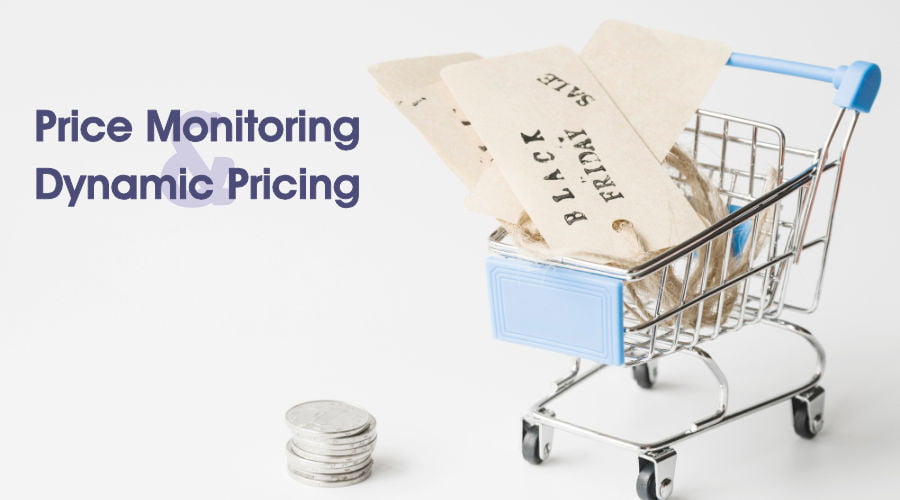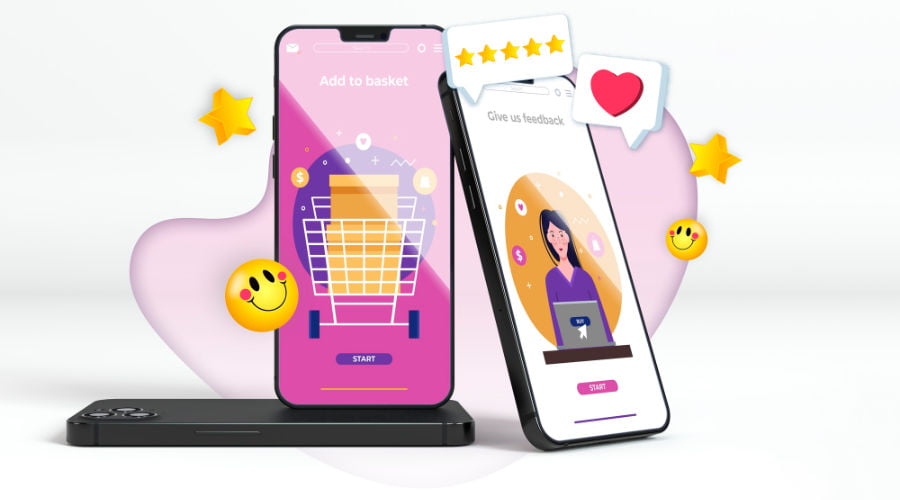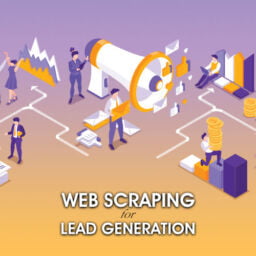
Today, the digital marketplace industry is highly competitive. Therefore, your e-commerce business must constantly adapt and innovate to stay ahead. One key strategy to achieve this is through the use of web scraping.
This article delves into the numerous use cases of web scraping in e-commerce, highlighting its importance as a tool for data-driven decision-making and business growth.
I. Definition of Web Scraping
Web scraping (aka web data extraction or web harvesting) is the process of collecting structured and unstructured information from websites using automated tools or scripts. The extracted data is typically saved in a local file or database and then analysed and used for various purposes.
In e-commerce, web scraping can help your business make informed decisions based on market trends, competitor strategies, and consumer preferences.
II. Web Scraping Techniques
There are several techniques for web scraping, each with its benefits and limitations. Here are some of the most common methods.
Manual Copy-Pasting
You must manually visit websites and copy the required data into a local file or spreadsheet. While this method is simple and doesn’t require specialised tools, it can be extremely time-consuming and prone to errors.
Regular Expression Parsing
Regular expressions (RegEx) are patterns that match specific text strings in a given input. Using RegEx, web scrapers can identify and extract relevant data from web pages. However, this technique can be complex and hard to maintain, as even small changes to the website structure can cause the RegEx patterns to break.
HTML Parsing
HTML parsing analyses the HTML code of a web page and extracts data based on the structure and tags. This method is more flexible than RegEx and can handle website changes better. However, it may require manual intervention if the website structure changes significantly.
Web Scraping Libraries and Frameworks
Several programming languages, such as Scala, Python, Ruby, and JavaScript, have libraries and frameworks designed specifically for web scraping. These tools offer advanced features, such as handling JavaScript rendering, managing cookies, and automating browser actions, making web scraping more efficient and accurate. Some popular libraries and frameworks include Beautiful Soup, Scrapy, and Selenium.
Web Scraping API
Application Programming Interfaces (APIs) are a more efficient and reliable method for data extraction, as they allow direct access to a website’s data without the need to parse HTML. However, not all websites provide APIs. And even those that do it may impose rate limits or restrict the available data.
When you choose a web scraping service or self-service data scraping tool, verify if it provides a mix of techniques and features for maximum flexibility, scalability, and accuracy.
III. Web Scraping Use Cases in E-Commerce
Price Monitoring and Dynamic Pricing

Price monitoring and dynamic pricing are essential strategies in the e-commerce industry. They help your business stay competitive and maximise profits. Web scraping allows you to gather real-time data on competitor pricing and market trends, which you can exploit to inform your company’s pricing strategies.
Price Monitoring
Price monitoring involves tracking competitors’ products and services prices to understand their market positioning and then make informed pricing decisions. Web scraping can automate the process of collecting pricing data from competitor websites, making it faster, more accurate, and less labour-intensive than manual methods.
To implement price monitoring using web scraping, follow these steps.
a. Identify target websites: Start by identifying the competitors whose prices you want to monitor. This may include direct competitors, industry leaders, or niche players.
b. Select relevant data points: Determine the specific information you need to collect, such as product names, prices, discounts, promotions, and stock levels.
c. Develop a web scraper: Create a custom web scraper or use pre-built web scraping tools, libraries or frameworks. Alternatively, find a data expert/consultant who can identify an efficient data solution. Your web scraper should be able to navigate the target websites, locate the relevant data points, and extract the required information.
d. Schedule data extraction: Set up your web scraper to run at regular intervals and collect up-to-date pricing data. The frequency of data extraction will depend on the volatility of the market and the resources available.
e. Store and analyse the data: Save the extracted data in a structured format, such as a CSV file or a database, and use data analysis tools or techniques to identify trends, patterns, and insights. A good web scraping software would create a professionally formatted CSV or database optimised for data mining and analytics.
Dynamic Pricing
Dynamic pricing consists of adjusting prices based on various factors, such as demand, supply, competitor pricing, and market trends. It helps you optimise your pricing strategies to attract customers and boost sales. Again, web scraping provides valuable data to inform dynamic pricing models.
Here are the steps to implement dynamic pricing using web scraping data.
a. Gather relevant data: Use web scraping to collect real-time data on competitor pricing, as well as other market factors that may affect pricing, such as customer preferences, seasonal trends, and economic indicators.
b. Develop a dynamic pricing model: Create a pricing model that considers the collected data and other relevant factors, such as production costs, profit margins, and business objectives. This model may use machine learning, statistical analysis, or data science techniques to predict optimal prices based on the input data.
c. Integrate the dynamic pricing model with your e-commerce platform: This allows you to automatically update product prices based on the real-time data collected by your web scraper.
d. Monitor and evaluate the results: Continuously monitor the performance of your dynamic pricing model, analysing its impact on sales, revenue, and customer satisfaction. Make adjustments to the model as needed to optimise its effectiveness.
Product Assortment and Inventory Management
Product assortment and inventory management are critical for a successful e-commerce business.
Product Assortment
Product assortment refers to the variety of products a business offers. Product assortment optimisation can help your e-commerce business cater to its target audience and maximise sales. Web scraping can gather information on competitor product listings, customer preferences, and market trends.
Inventory Management
Inventory management involves tracking and managing the stock levels of products in an e-commerce business. Efficient inventory management helps you maintain optimal stock levels, reduce costs, avoid stockouts or overstocking, and increase customer satisfaction and sales. Web scraping is ideal for monitoring competitor inventory levels and collecting data on market trends.
After extracting, storing, and analysing the data —see steps a) to e) above—you must optimise the product assortment and adjust the inventory levels.
f. Product assortment optimisation: Based on the insights gathered from the data analysis, make informed decisions about your product assortment, such as adding new products, discontinuing underperforming products, or expanding into new categories.
g. Inventory levels adjustment: After getting the insights from your data analytics activity, make informed decisions about your inventory management, such as adjusting stock levels, setting reorder points, or implementing demand forecasting techniques.
Competitor Analysis
Analysing competitors using web scraping is a powerful strategy for your e-commerce platform to gain insights into their competitors’ strategies, offerings, promotions, and performance. This information can help you identify your strengths and weaknesses, opportunities for growth and differentiation.
Here are the steps to analyse competitors using web scraping.
a. Define objectives: Start by outlining your specific competitor analysis goals. This could include understanding competitor pricing strategies, product assortments, promotional activities, customer reviews, or search engine optimisation techniques.
b. Identify target websites: Select your competitors’ websites or marketplaces. Choose a representative sample of direct competitors, industry leaders, and niche players to understand the competitive landscape.
c. Define relevant data points: Product names, descriptions, prices, categories, images, customer reviews, promotions, or backlink profiles.
d. Develop a web scraper: Create a tailored web scraper using a programming language if you are a developer or hire one. Alternatively, subscribe to a no-code web scraping app or service that can do everything for you.
e. Schedule data extraction: Let the scraper run regularly to extract up-to-date competitor data automatically (for example, daily, weekly, biweekly or monthly, depending on your specific market).
f. Store and clean the data: Save the extracted data in a structured format, such as an Excel file or a database. Then, clean and preprocess your data to remove inconsistencies, duplicates, and irrelevant information. This way, your analysis will be based on accurate and reliable data.
g. Analyse the data: Use data analysis software or techniques to identify trends, patterns, and insights in the collected data. This could involve quantitative analysis (such as calculating average prices or discount rates), qualitative analysis (such as sentiment analysis of customer reviews), or data visualisation (such as creating graphs and charts to identify patterns).
h. Benchmark against your business: Compare the insights you gathered from the competitor analysis with your business data. This will allow you to identify areas where you excel or need improvements. This is the best way to understand your market positioning and inform your strategies for growth and differentiation.
i. Implement and monitor changes: Based on the insights from your competitor analysis, implement changes to your business strategies, product offerings, or marketing tactics as needed. Continuously monitor the performance of these changes, and make adjustments accordingly to optimise their effectiveness.
l. Repeat the process: Regularly update your competitor analysis to stay informed about changes in the competitive landscape and maintain an edge in the market.
Personalised Marketing for E–Commerce

Personalised marketing involves tailoring marketing messages, promotions, and recommendations to individual customers based on their preferences, behaviours, and needs. By leveraging web scraping, your company can better understand its target audience and develop personalised marketing campaigns that resonate with customers and drive conversions.
Here’s how you can apply web scraping for personalised marketing in e-commerce.
a. Collect Customer Data: You can use web scraping to gather data on customer preferences, behaviours, and demographics from various online sources, such as social media platforms, forums, blogs, and review websites. This data can help you create a detailed profile of their target audience and identify key customer segments.
b. Analyse Competitor Strategies: By scraping competitor websites and analysing their marketing messages, promotions, and customer reviews, you can gain insights into successful personalised marketing strategies and identify opportunities for differentiation.
c. Identify Customer Needs and Preferences: Web scraping can help you discover customer pain points, preferences, and needs by analysing customer-generated content, such as product reviews, forum discussions, and social media posts. This information helps you tailor marketing messages and offers to address market demand.
d. Track Your Customer Behaviour: Through web scraping, you can monitor, aggregate, and analyse customer interactions with a website, such as browsing history, click patterns, and purchases.
e. Send Personalised Recommendations: Web scraping can find and extract data on similar products or complementary items from various sources, such as competitor websites, product catalogues, and review websites. After analysing this data, you can create personalised product recommendations for your customers, increasing the likelihood of conversions and enhancing the customer experience.
f. Send Personalised Promotions and Offers: Web scraping can help you gather data on market trends, competitors’ promotions and offers. The goal is to analyse customer preferences, behaviours, and demographics. This will allow you to deliver products and services that resonate with your target audience.
g. Create Personalised Content: Web scraping tools and services can collect and analyse data on trending topics, popular keywords, and customer interests from various online sources. You can then draw on this information to craft targeted content, such as blog posts, social media updates, and email newsletters. AI and GPT content-generating technology can support you in doing that automatically or with the supervision of an expert for lead generation.
h. Start a Personalised Retargeting Campaign: Once you collect data on customer behaviour, you can develop campaigns that display relevant ads to customers who have previously interacted with your website or products. This can improve conversions and marketing effectiveness.
E-commerce Customer Segmentation
Customer segmentation is a crucial marketing strategy for e-commerce businesses that involves dividing customers into distinct groups based on shared characteristics.
By leveraging web scraping, you can gather valuable data to create highly targeted marketing campaigns and personalised customer experiences to increase customer satisfaction, loyalty, and conversion rates.
Types of Data for Customer Segmentation
Web scraping can harvest a wide range of data relevant to customer segmentation. Here are the top four.
1. Demographic data: Age, gender, location, income, and other demographic factors can be scraped from various online sources, such as social media profiles, forums, and blogs.
2. Behavioral data: Browsing history, purchase patterns, and engagement metrics can be gathered by scraping customer interactions on e-commerce websites and social media platforms.
3. Preferences and interests: Customer needs and pain points can be identified by analysing product reviews, social media posts, and forum discussions.
4. Customer feedback: Customer satisfaction and sentiment data can be obtained by scraping customer reviews, ratings, and comments from e-commerce platforms, review websites, and social media channels.
As the e-commerce industry continues to evolve, your business needs to harness the power of data to stay competitive and drive growth. One such data extraction technique that has gained prominence in recent years is web scraping.
So, do you want your e-commerce business to thrive in a data-driven world? You must leverage web scraping and the related services and tools designed for your use cases.
Leverage web scraping for your e-commerce
Do it even without tech skills with a no-code visual tool.
Disclaimer: Always respect user privacy and copyright, follow ethical data scraping practices, and abide by the terms and conditions of the websites or platforms you’re scraping data from, as unauthorized data extraction may lead to legal or privacy issues. Therefore, ensure that your data collection and analysis methods are compliant. Furthermore, data can be noisy, unstructured, and constantly changing. Therefore, use a tool or service that can handle the volume and variety of data from multiple web sources. This article is for information purposes only and not intended as legal advice. Consult a lawyer for complete knowledge of local and international laws.
Credits: Featured image by rawpixel.com on Freepik


















[…] Alibaba generate massive amounts of data on product sales, customer reviews, and pricing dynamics. Scraping data from e-commerce platforms can provide insights into consumer preferences, product demand, and pricing […]